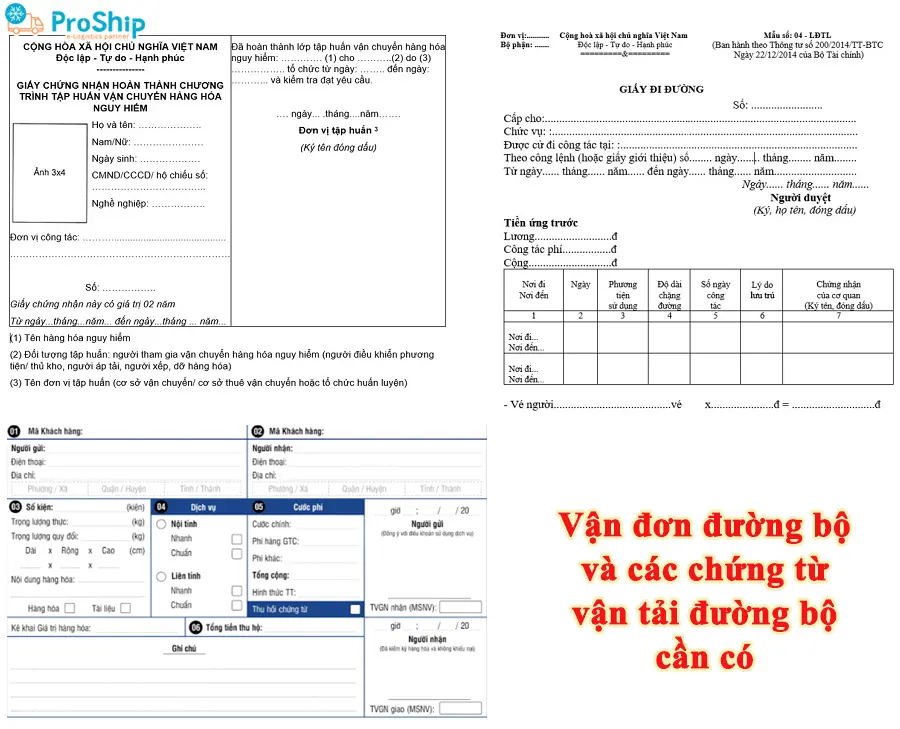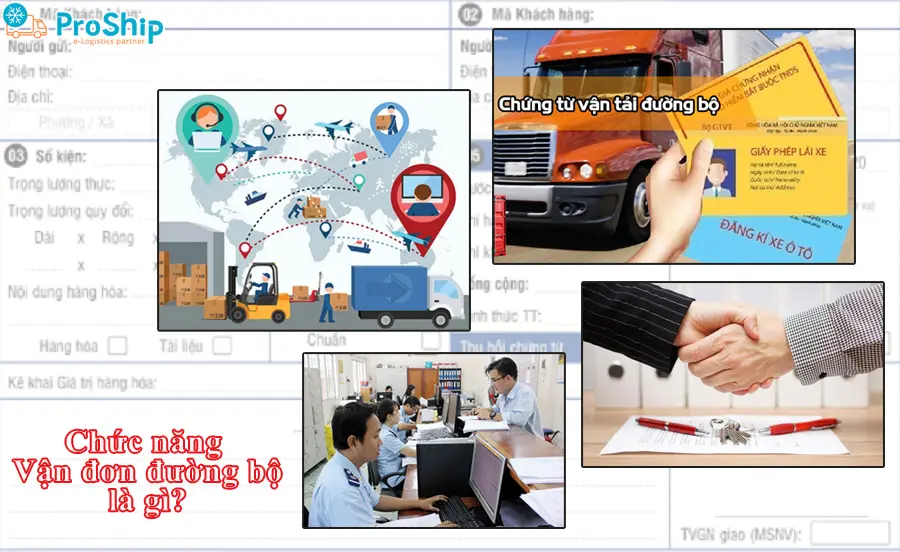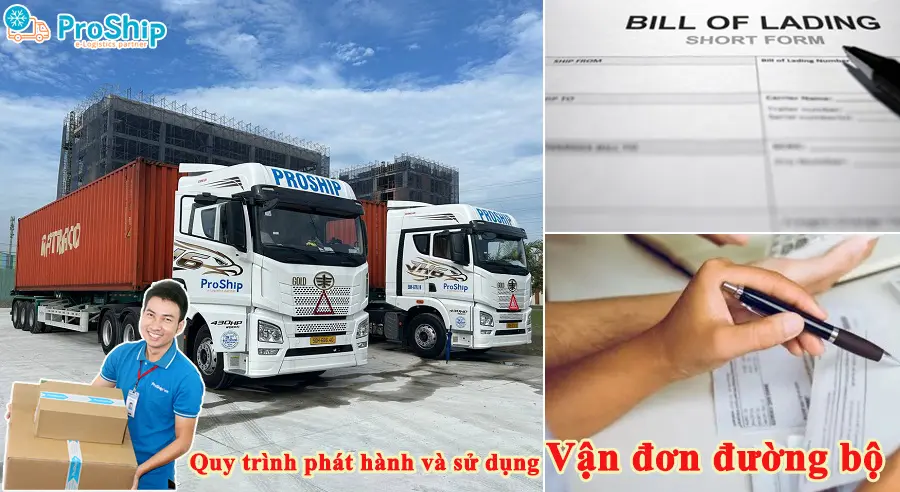x Bạn muốn biết nội dung, quy định, vai trò chức năng của vận đơn đường bộ là gì?
x Các chủ hàng, người gửi hàng, doanh nghiệp, shop online, các đơn vị vận chuyển, người bán, người mua,…cần tìm hiểu chi tiết về vận đơn đường bộ?
x Bạn chưa nắm rõ quy trình phát hành cũng như sử dụng vận đơn đường bộ thế nào?
Vận đơn đường bộ là tài liệu quan trọng trong vận tải hàng đường bộ. Với nhiều năm kinh nghiệm trong lĩnh vực vận chuyển container đường bộ Bắc Nam và liên vận Quốc tế, Proship.vn chúng tôi sẽ giải đáp cặn kẽ về khái niệm vận đơn đường bộ là gì? Có các loại vận đơn đường bộ thông dụng nào? Vai trò, chức năng của vận đơn đường bộ là gì?…ngay sau đây.
Vận đơn đường bộ: Khái niệm, nội dung và các loại vận đơn
Proship sẽ làm rõ định nghĩa vận đơn đường bộ và các nội dung trong vận đơn:
Khái niệm vận đơn đường bộ
Vận đơn đường bộ là gì? Vận đơn đường bộ là một loại chứng từ quan trọng trong vận chuyển hàng hóa bằng phương thức đường bộ. Đây là văn bản pháp lý giữa người gửi hàng, đơn vị vận chuyển và người nhận, cung cấp các thông tin chi tiết về hàng hóa và điều kiện vận chuyển.

Tài liệu này ghi nhận quá trình tiếp nhận và giao nhận, đồng thời thể hiện cam kết của bên vận chuyển trong việc đảm bảo an toàn cho hàng hóa đến nơi nhận theo đúng thỏa thuận.
Nội dung chính của vận đơn đường bộ
Vận đơn đường bộ gồm các nội dung sau:
- Thông tin hàng hóa: Loại hàng, số lượng, trọng lượng, đặc điểm nhận dạng;
- Thông tin người gửi: Bao gồm tên và địa chỉ;
- Thông tin người nhận: Tên, địa chỉ, và thông tin liên lạc;
- Thông tin phương tiện vận chuyển: Biển số xe, số chuyến, tài xế phụ trách;
- Ngày và nơi phát hành vận đơn: Xác định thời gian và địa điểm vận chuyển;
- Cước phí và phụ phí: Ghi rõ chi phí vận chuyển và các khoản phí liên quan khác.
Các loại vận đơn đường bộ
Trong logistics đường bộ, vận đơn được phân loại theo nhiều yếu tố để phù hợp với nhu cầu vận chuyển và bảo vệ quyền lợi của các bên. Cụ thể:
Vận đơn theo đơn vị cấp vận đơn có:
- Vận đơn của nhà vận chuyển (Carrier Bill of Lading);
- Vận đơn của người giao nhận (Forwarder’s Bill of Lading).
Vận đơn theo phương tiện vận chuyển có:
- Vận đơn xe tải (Truck Bill of Lading);
- Vận đơn container (Container Bill of Lading);
- Vận đơn xe chuyên dụng (Specialized Vehicle Bill of Lading).
Vận đơn theo tính sở hữu có:
- Vận đơn có thể chuyển nhượng (Negotiable Bill of Lading);
- Vận đơn không chuyển nhượng (Non-negotiable Bill of Lading).
Vận đơn theo phê chú trên tình trạng lô hàng có:
- Vận đơn hoàn hảo (Clean Bill of Lading);
- Vận đơn không hoàn hảo (Unclean Bill of Lading).
Vận đơn theo cách thức chuyên chở có:
- Vận đơn theo chuyến (Trip Bill of Lading);
- Vận đơn theo hợp đồng dài hạn (Long-term Contract Bill of Lading).
Chức năng của Vận đơn đường bộ là gì?
Hãy cùng Proship tham khảo các chức năng chính của vận đơn đường bộ sau đây:
Ghi nhận thông tin hàng hóa
Thông tin chi tiết hàng hóa như số lượng, trọng lượng và các đặc điểm khác,…Điều này giúp các bên liên quan nhận diện và kiểm soát hàng hóa trong suốt quá trình vận chuyển.
Xác nhận thông tin vận tải hàng
Ghi nhận thông tin hàng hóa đang được vận chuyển từ người gửi đến người nhận, các thông tin về phương tiện, lộ trình và thời gian dự kiến giao nhận. Qua đó, nhằm đảm quá trình vận chuyển đang được thực hiện theo đúng thỏa thuận.
Cơ sở khai báo hải quan
Khi mặt hàng cần thiết được xuất khẩu hoặc nhập khẩu qua biên giới, vận đơn đường bộ được coi như một chứng từ thiết yếu để kê khai hải quan, phục vụ quá trình làm các thủ tục liên quan đến xuất nhập khẩu.

Quản lý quá trình vận tải hàng
Cung cấp thông tin về tình trạng vận chuyển, phương tiện vận chuyển, thời gian giao nhận, giúp kiểm soát và điều phối quá trình vận chuyển hiệu quả.
Quản lý thanh toán
Vận đơn là căn cứ để tính toán và thanh toán chi phí vận chuyển. Các khoản phí liên quan đến dịch vụ vận tải, bảo hiểm, phụ phí khác sẽ được ghi rõ trong vận đơn, giúp các bên liên quan dễ dàng quản lý và thực hiện thanh toán.
Chứng từ mua bán, cầm cố, chuyển nhượng
Vận đơn cũng có thể đóng vai trò là chứng từ pháp lý trong các giao dịch mua bán, cầm cố hoặc chuyển nhượng hàng hóa, đảm bảo tính pháp lý giữa các bên liên quan.
Quy định các loại chứng từ vận tải đường bộ cần có
Cùng Proship tìm hiểu xem các loại chứng từ quan trọng trong vận tải đường bộ là gì nhé!
Giấy tờ xe
Trong chứng từ vận đơn đường bộ, các loại giấy tờ xe không thể thiếu là:
- Giấy chứng nhận bảo hiểm các loại;
- Giấy lưu hành cho xe quá khổ, quá tải (nếu có);
- Phù hiệu xe chạy hợp đồng (đối với xe khách chạy hợp đồng);
- Giấy đăng ký xe;
- Giấy chứng nhận kiểm định có dán tem kiểm định;
- Sổ nhật trình chạy xe (đối với xe khách tuyến cố định).
Giấy tờ của chủ phương tiện
Giấy tờ của chủ phương tiện là giấy chứng nhận kinh doanh vận tải theo ngành nghề cụ thể nào đó. Cụ thể, giấy tờ này trong vận đơn đường bộ như sau:
* Giấy tờ người điều khiển phương tiện:
Giấy tờ của người điều khiển phương tiện bao gồm:
- Giấy chứng nhận huấn luyện vận chuyển hàng của người điều khiển phương tiện;
- Giấy phép lái xe của người điều khiển phương tiện.
* Các loại giấy tờ khác:
Ngoài những chứng từ trên còn có các loại giấy tờ quan trọng khác như:
- Hợp động vận chuyển;
- Giấy đi đường;
- Phiếu thu cước;
- Giấy gửi hàng.
Quy trình phát hành và sử dụng vận đơn đường bộ
Quy trình phát hành và sử dụng vận đơn đường bộ được tiến hành như sau:
Bước 1: Lập vận đơn dựa trên thông tin hàng hóa
Người gửi hàng cung cấp thông tin chi tiết về hàng hóa cho Đơn vị vận chuyển. Từ đó, vận đơn sẽ được lập và ghi đầy đủ thông tin cần thiết như tên người gửi, người nhận, phương tiện vận chuyển, và các điều khoản liên quan.
Bước 2: Kiểm tra, xác nhận và ký tên trên vận đơn
Đảm bảo các thông tin về hàng hóa, người gửi và người nhận chính xác. Các bên liên quan (người gửi, người vận chuyển) sẽ xác nhận thông tin và ký tên trên vận đơn, hoàn thiện thủ tục pháp lý cần thiết.

Bước 3: Giao nhận hàng dựa trên vận đơn và lưu trữ vận đơn để hỗ trợ kế toán, xử lý tranh chấp (nếu có)
Sau khi vận đơn được xác nhận, hàng hóa được giao đến người nhận. Vận đơn được lưu trữ cho mục đích kiểm tra và xác minh thông tin về giao nhận hàng hóa. Ngoài ra, vận đơn cũng sẽ là căn cứ pháp lý hỗ trợ xử lý các vấn đề liên quan đến kế toán, thanh toán, và tranh chấp nếu có.
Trên đây là thông tin cần biết về Vận đơn đường bộ, gồm Vận đơn đường bộ là gì, vai trò ra sao, quy trình phát hành vận đơn thế nào mà Proship đã kịp thời ghi nhận và chia sẻ tới quý bạn đọc cũng như các tư nhân, doanh nghiệp, người gửi hàng,…đang có nhu cầu update mẫu vận đơn cùng những quy định đi kèm có thể tham khảo. Mọi thắc mắc, liên hệ 0909 344 247 để được giải đáp.

